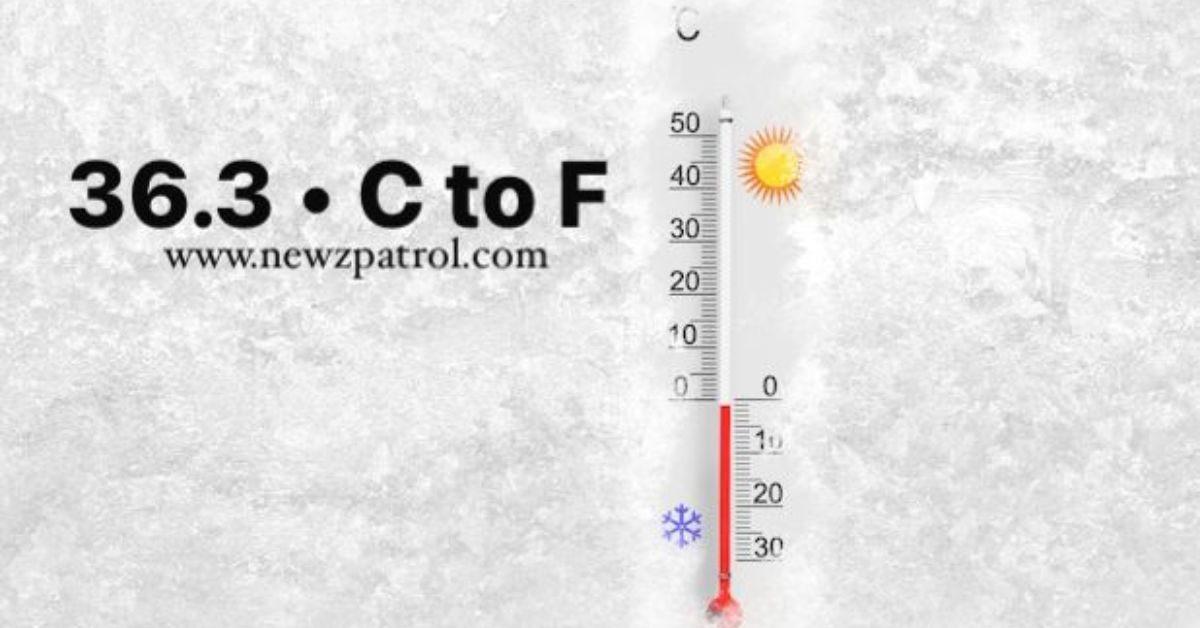Temperature plays a crucial role in our daily lives, from cooking to health monitoring. Have you ever wondered what 36.3 C to F Fahrenheit? Understanding this conversion is not just about numbers; it impacts how we interpret temperature readings and make decisions based on them.
Whether you’re checking your body temperature or simply curious about weather forecasts, knowing the equivalent of 36.3 C to F can enhance your knowledge and accuracy. Today, we’ll explore the significance of this specific temperature measurement and how it affects various aspects of our lives.
So let’s dive into the fascinating world of Celsius and Fahrenheit conversions!
Conversion of Celsius to Fahrenheit
Celsius and Fahrenheit are two commonly used temperature scales. Understanding how to convert between them is essential for various reasons, including travel, cooking, and health monitoring.
The Celsius scale is based on the freezing and boiling points of water. It defines 0°C as the temperature where water freezes and 100°C as the boiling point at standard atmospheric pressure. In contrast, Fahrenheit sets the freezing point at 32°F and the boiling point at 212°F.
To convert Celsius to Fahrenheit, you can use a simple formula: multiply the Celsius value by 9/5 and then add 32. This calculation ensures that temperatures are accurately represented across both scales.
For example, when converting our focal temperature of 36.3 C to F:
(36.3 × 9/5) + 32 = approximately 97.34°F.
This straightforward approach allows anyone to make quick conversions without needing complex tools or charts readily available in their environment—perfect for those everyday situations!
Conversion Formula
Understanding how to convert Celsius to Fahrenheit can be quite useful, especially when dealing with specific temperatures like 36.3°C. The conversion formula is simple but crucial for accuracy.
To convert Celsius to Fahrenheit, use the formula: \( F = \frac{9}{5}C + 32 \). In this equation, “F” represents the temperature in degrees Fahrenheit and “C” stands for degrees Celsius.
When you plug in 36.3°C into this formula, the calculation becomes straightforward. Start by multiplying 36.3 by \( \frac{9}{5} \), which equals approximately 65.34°F before adding 32.
So, when you complete that step of addition, you’ll find that 36.3°C converts to about 97.43°F.
This conversion is not only helpful in medical settings but also plays a significant role in various scientific and culinary applications where precise temperature readings are critical.
Practical Uses of Knowing 36.3°C in Fahrenheit
Understanding the temperature of 36.3°C in Fahrenheit can be beneficial in various practical scenarios. In medical settings, for instance, this specific body temperature is often considered within the normal range for healthy adults. Knowing its Fahrenheit equivalent helps healthcare professionals communicate effectively across different regions and systems.
For those traveling or living in countries that use Fahrenheit, being aware of this conversion can enhance comfort and well-being. If you know that 36.3°C translates to approximately 97.34°F, you’ll have a better sense of what feels normal versus extreme weather conditions.
In cooking and baking, precise temperature control is crucial. Many recipes reference temperatures in Fahrenheit; understanding how to convert Celsius ensures your dishes come out perfectly every time.
Fitness enthusiasts also benefit from this knowledge when monitoring their body’s responses during exercise routines. Recognizing your ideal body temperature range enhances workout efficiency while minimizing health risks associated with overheating or hypothermia.
Educators teaching science concepts can utilize these conversions to explain thermal dynamics easily while engaging students with real-world applications they encounter daily.
Common Temperature Conversions
Temperature conversions are essential in various fields, from cooking to scientific research. Understanding common conversions helps facilitate communication across different regions and disciplines.
One of the most frequently used conversions is between Celsius and Fahrenheit. In many parts of the world, Celsius is standard for weather forecasts, while Fahrenheit remains popular in countries like the United States. Knowing 36.3 C to F can be relevant when discussing health concerns or environmental conditions.
Another important temperature scale is Kelvin, mainly used in science and engineering contexts. To convert Celsius to Kelvin, simply add 273.15 to the Celsius value. This conversion plays a crucial role in thermodynamics and other scientific applications.
For those who enjoy baking or cooking, understanding these conversions can make all the difference in achieving perfect results. Recipes often use either Fahrenheit or Celsius; hence familiarity with both scales allows cooks to adapt easily.
Being aware of temperature ranges for safety is vital as well—especially during extreme weather conditions or medical situations such as fever monitoring where knowing specific readings like 36.3°C may indicate normal body temperature for adults.
Application in Everyday Life
Understanding temperature conversions, such as 36.3 C to F, plays a crucial role in our daily lives. This knowledge is particularly vital in health and wellness contexts. For instance, normal body temperature typically ranges around this value in Celsius.
When monitoring fever or illness, knowing how to convert temperatures accurately can help you make informed decisions about seeking medical care. A fever usually starts at about 100.4°F; thus, recognizing that 36.3°C equals approximately 97.34°F shows no cause for alarm.
In cooking and baking, precision matters significantly. Recipes often specify temperatures in Fahrenheit or Celsius depending on the region of origin. If you’re following a recipe from overseas that uses Celsius measurements, converting them to Fahrenheit ensures your dish turns out perfectly cooked.
Traveling also presents scenarios where understanding these conversions is beneficial. Different countries may use different measurement systems when reporting weather conditions or climate data.
Industries like pharmaceuticals rely heavily on accurate temperature readings for storage and transportation of products—many requiring specific conditions measured either way.
Conclusion
Understanding the conversion of 36.3°C to Fahrenheit is beneficial, especially in a world where temperature scales vary by region and field. Knowing this specific temperature can help track health indicators or enhance experiences during travel.
The formula for converting Celsius to Fahrenheit—F = (C × 9/5) + 32—makes it straightforward to translate temperatures. With just a little math, you see that 36.3°C converts to approximately 97.34°F. This knowledge lets individuals monitor their body temperature more effectively, as normal human body temp ranges are often expressed in Fahrenheit.
Practical applications extend beyond personal health monitoring into cooking, weather forecasting, and scientific research. Whether you’re following an international recipe or checking if it’s too hot outside for your outdoor plans, knowing how these figures relate empowers better decision-making.
Common conversions like room temperature—which typically hovers around 20-22°C (68-72°F)—and boiling point water at sea level (100°C or 212°F) further illustrate the importance of mastering these conversions in daily life.
Being well-informed about various temperature scales makes everyday tasks more manageable and enjoyable while ensuring you stay connected with global standards and practices.
FAQS
What is 36.3°C in Fahrenheit?
36.3°C is equivalent to approximately 97.34°F.
How do you convert Celsius to Fahrenheit?
To convert Celsius to Fahrenheit, use the formula: F=C×95+32\text{F} = \text{C} \times \frac{9}{5} + 32F=C×59+32.
Is 36.3°C a normal body temperature?
Yes, 36.3°C is within the range of normal body temperature, which typically varies from 36.1°C to 37.2°C (97°F to 99°F).
Read More Articles On Our Site!











